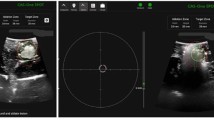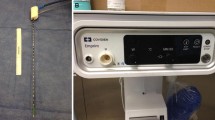Abstract
Microwave ablation (MWA) is a newly developing minimally invasive thermal therapies technology. The ablation region obtained during MWA mainly depends on the type and efficiency of the trocar as well as the energy transfer from the generator to the biological tissue. In the present article, a novel trocar for MWA therapies has been proposed. A 3-dimensional tumor-embedded hepatic gland ablated with the novel MWA trocar has been numerically analyzed using finite element method–based software. The novel trocar consists of a flexible dual tine supplied with a microwave power of 15 W at 2.45/6 GHz for an ablation time of 10 min for all the cases. Various combinations of supplied energy and deploying lengths result in tumor ablations ranging from 2.7 to 4 cm in diameter. Supplying energy at high frequency (6 GHz) to the trocar results in ablating tumors (> 4 cm) with spherical ablation region. The novel trocar generated large ablation regions which are 2–3 times bigger than the tumors obtained using existing single-slot non-cooled trocars. This research on novel trocar may help clinicians in treating large size tumors of symmetric and asymmetric shapes by overcoming the problem associated with precise position of trocar into the tissue.
Graphical abstract





















Similar content being viewed by others
References
Demir T, Lee SS, Kaseb AO (2021) Systemic therapy of liver cancer. In: Advances in Cancer Research. Academic Press Inc., 257–294
Ferlay J, Colombet M, Soerjomataram I et al (2019) Estimating the global cancer incidence and mortality in 2018: GLOBOCAN sources and methods. Int J Cancer 144:1941–1953
Sahin T, Serin A, Emek E et al (2019) Effectiveness of noninvasive fibrosis markers for the prediction of hepatocellular carcinoma in chronic hepatitis B and chronic hepatitis B+D induced cirrhosis. Transplant Proc 51:2397–2402. https://doi.org/10.1016/j.transproceed.2019.01.193
Gosalia AJ, Martin P, Jones PD (2017) Advances and future directions in the treatment of hepatocellular carcinoma. Gastroenterol Hepatol (N Y) 13:
Mazzaferro V, Regalia E, Doci R et al (1996) Liver transplantation for the treatment of small hepatocellular carcinomas in patients with cirrhosis. N Engl J Med 334:693–700. https://doi.org/10.1056/nejm199603143341104
Bhoori S, Schiavo M, Russo A, Mazzaferro V (2007) First-line treatment for hepatocellular arcinoma: resection or transplantation? Transplant Proc 39:2271–2273. https://doi.org/10.1016/j.transproceed.2007.06.015
Beard RE, Hanto DW, Gautam S, Miksad RA (2013) A comparison of surgical outcomes for noncirrhotic and cirrhotic hepatocellular carcinoma patients in a Western institution. Surgery (United States) 154:545–555. https://doi.org/10.1016/j.surg.2013.02.019
Wong TCL, Lo CM (2013) Resection strategies for hepatocellular carcinoma. Semin Liver Dis 33:273–281. https://doi.org/10.1055/s-0033-1351782
Nishikawa H, Kimura T, Kita R, Osaki Y (2013) Radiofrequency ablation for hepatocellular carcinoma. Int J Hyperth 29:558–568
Diederich CJ (2005) Thermal ablation and high-temperature thermal therapy: overview of technology and clinical implementation. Int J Hyperthermia 8:745–753
Davalos RV, Mir LM, Rubinsky B (2005) Tissue ablation with irreversible electroporation. Ann Biomed Eng 33:223–231. https://doi.org/10.1007/S10439-005-8981-8
Nuccitelli R, Pliquett U, Chen X et al (2006) Nanosecond pulsed electric fields cause melanomas to self-destruct. Biochem Biophys Res Commun 343:351–360. https://doi.org/10.1016/J.BBRC.2006.02.181
Groeschl RT, Pilgrim CHC, Hanna EM et al (2014) Microwave ablation for hepatic malignancies: a multiinstitutional analysis. Ann Surg 259:1195–1200. https://doi.org/10.1097/SLA.0000000000000234
Gala K, Shetty N, Patel P, Kulkarni S (2020) Microwave ablation: how we do it? Indian J Radiol Imag 30:206–213. https://doi.org/10.4103/IJRI.IJRI_240_19/ID/JR_47
Keangin P, Rattanadecho P, Wessapan T (2011) An analysis of heat transfer in liver tissue during microwave ablation using single and double slot antenna. Int Commun Heat Mass Transfer 38:757–766. https://doi.org/10.1016/j.icheatmasstransfer.2011.03.027
Lee M, Son T (2019) Helical slot antenna for the microwave ablation. Int J Antennas Propag 2019. https://doi.org/10.1155/2019/2126879
Lin JC, Wang YJ (1996) The cap-choke catheter antenna for microwave ablation treatment. IEEE Trans Biomed Eng 43:657–660. https://doi.org/10.1109/10.495286
Brace CL, Laeseke PF, Van Der Weide DW, Lee FT (2005) Microwave ablation with a triaxial antenna: results in ex vivo bovine liver. IEEE Trans Microw Theory Tech 53:215–220
Alnassan H, Kastler A, Xia W, Kastler B (2014) Modified dipole antenna for directional microwave ablation using 3D numerical simulation. The 7th 2014 Biomedical Engineering International Conference, Fukuoka, pp 1–4. https://doi.org/10.1109/BMEiCON.2014.7017406
Yang D, Bertram JM, Converse MC et al (2006) A floating sleeve antenna yields localized hepatic microwave ablation. IEEE Trans Biomed Eng 53:533–537. https://doi.org/10.1109/TBME.2005.869794
Wu X, Liu B, Xu B (2016) Theoretical evaluation of high frequency microwave ablation applied in cancer therapy. Appl Therm Eng 107:501–507. https://doi.org/10.1016/j.applthermaleng.2016.07.010
Bercich RA, Duffy DR, Irazoqui PP (2013) Far-field RF powering of implantable devices: safety considerations. IEEE Trans Biomed Eng 60:2107–2112. https://doi.org/10.1109/TBME.2013.2246787
Liu D, Brace CL (2014) CT imaging during microwave ablation: analysis of spatial and temporal tissue contraction. Med Phys 41. https://doi.org/10.1118/1.4897381
Sommer CM, Sommer SA, Mokry T, Gockner T, Gnutzmann D, Bellemann N, Schmitz A, Radeleff BA, Kauczor HU, Stampfl U, Pereira PL (2013) Quantification of tissue shrinkage and dehydration caused by microwave ablation: experimental study in kidneys for the estimation of effective coagulation volume. J Vasc Interv Radiol 24(8):1241–8. https://doi.org/10.1016/j.jvir.2013.04.008
Farina L, Weiss N, Nissenbaum Y, et al. (2014) Characterisation of tissue shrinkage during microwave thermal ablation. 30:419–428. https://doi.org/10.3109/02656736.2014.957250
Amabile C, Farina L, Lopresto V et al (2017) Tissue shrinkage in microwave ablation of liver: an ex vivo predictive model. Int J Hyperth 33:101–109. https://doi.org/10.1080/02656736.2016.1208292/SUPPL_FILE/IHYT_A_1208292_SM5297.ZIP
Rossmann C, Garrett-Mayer E, Rattay F, Haemmerich D (2013) Dynamics of tissue shrinkage during ablative temperature exposures. Physiol Meas 35:55. https://doi.org/10.1088/0967-3334/35/1/55
Berjano EJ (2006) Theoretical modeling for radiofrequency ablation: state-of-the-art and challenges for the future. Biomed Eng Online 5:24. https://doi.org/10.1186/1475-925X-5-24
Mohtashami Y, Luyen H, Hagness SC, Behdad N (2018) Non-coaxial-based microwave ablation antennas for creating symmetric and asymmetric coagulation zones. J Appl Phys 123:214903. https://doi.org/10.1063/1.5019267
Hanks BW, Frecker M, Moyer M (2016) Design of a compliant endoscopic ultrasound-guided radiofrequency ablation probe. Proc ASME Des Eng Tech Conf. Am Soc Mech Eng (ASME)
Wallach D, Toporek G, Weber S, et al. (2014) Comparison of freehand-navigated and aiming device-navigated targeting of liver lesions. International Journal of Medical Robotics and Computer Assisted Surgery 10:. https://doi.org/10.1002/rcs.1505
Saito K, Hayashi Y, Yoshimura H, Ito K (2000) Heating characteristics of array applicator composed of two coaxial-slot antennas for microwave coagulation therapy. IEEE Trans Microw Theory Tech 48:1800–1806. https://doi.org/10.1109/22.883857
Satish V, Kumar J, Repaka R (2019) Analysis of ablation volume produced during microwave ablation of breast cancerous lesion using fourier and non-fourier models. ASME Int Mech Eng Congr Expos, Proc (IMECE). Am Soc Mech Eng (ASME)
Sebek J, Curto S, Bortel R, Prakash P (2017) Analysis of minimally invasive directional antennas for microwave tissue ablation. Int J Hyperth 33:51–60. https://doi.org/10.1080/02656736.2016.1195519
Pennes HH (1948) Analysis of tissue and arterial blood temperatures in the resting human forearm. 1:93–122. https://doi.org/10.1152/JAPPL.1948.1.2.93
Chang IA, Nguyen UD (2004) Thermal modeling of lesion growth with radiofrequency ablation devices. Biomed Eng Online 3:1–19. https://doi.org/10.1186/1475-925X-3-27
Radosevic A, Prieto D, Burdío F, et al. (2021) Short pulsed microwave ablation: computer modeling and ex vivo experiments. Int J Hyperth 38. https://doi.org/10.1080/02656736.2021.1894358
Sturesson C, Andersson-Engels S (1995) A mathematical model for predicting the temperature distribution in laser-induced hyperthermia. Experimental evaluation and applications. Phys Med Biol 40:2037–2052. https://doi.org/10.1088/0031-9155/40/12/003
Yang D, Converse MC, Mahvi DM, Webster JG (2007) Measurement and analysis of tissue temperature during microwave liver ablation. IEEE Trans Biomed Eng 54:150–155. https://doi.org/10.1109/TBME.2006.884647
Selmi M, bin Dukhyil AA, Belmabrouk H, (2019) Numerical analysis of human cancer therapy using microwave ablation. Appl Sci 10:211. https://doi.org/10.3390/app10010211
Dekker A (1959) Electrical Engineering Materials, Prentice Hall, Englewood Cliffs, NJ
Balanis C (1989) Advanced engineering electromagnetics. Wiley & Sons Inc.
Prakash P, Converse MC, Webster JG, Mahvi DM (2009) An optimal sliding choke antenna for hepatic microwave ablation. IEEE Trans Biomed Eng 56:2470–2476. https://doi.org/10.1109/TBME.2009.2025264
Wang P, Converse MC, Webster JG, Mahvi DM (2009) “Improved” calculation of reflection coefficient for coaxial antennas with feed gap effect. IEEE Trans Antennas Propag 57:559–563. https://doi.org/10.1109/TAP.2008.2011411
Knavel E, Hinshaw J, … ML-AJ of, 2012 undefined (2012) High-powered gas-cooled microwave ablation: shaft cooling creates an effective stick function without altering the ablation zone. Am Roentgen Ray Soc 198. https://doi.org/10.2214/AJR.11.6503
Yoon J, Cho J, Kim N et al (2011) High-frequency microwave ablation method for enhanced cancer treatment with minimized collateral damage. Int J Cancer 129:1970–1978. https://doi.org/10.1002/ijc.25845
Acknowledgements
The authors would like to acknowledge the Indian Institute of Technology Ropar for providing essential infrastructure to carry out the present research.
Funding
This work was supported by the Science and Engineering Research Board (SERB), Government of India [grant number CRG/2020/004448].
Author information
Authors and Affiliations
Corresponding author
Ethics declarations
Conflict of interest
The authors declare no competing interests.
Additional information
Publisher's note
Springer Nature remains neutral with regard to jurisdictional claims in published maps and institutional affiliations.
Rights and permissions
Springer Nature or its licensor (e.g. a society or other partner) holds exclusive rights to this article under a publishing agreement with the author(s) or other rightsholder(s); author self-archiving of the accepted manuscript version of this article is solely governed by the terms of such publishing agreement and applicable law.
About this article
Cite this article
Satish, V., Repaka, R. Microwave ablation trocar for ablating cancerous tumors: a numerical analysis. Med Biol Eng Comput 61, 1113–1131 (2023). https://doi.org/10.1007/s11517-023-02781-7
Received:
Accepted:
Published:
Issue Date:
DOI: https://doi.org/10.1007/s11517-023-02781-7




